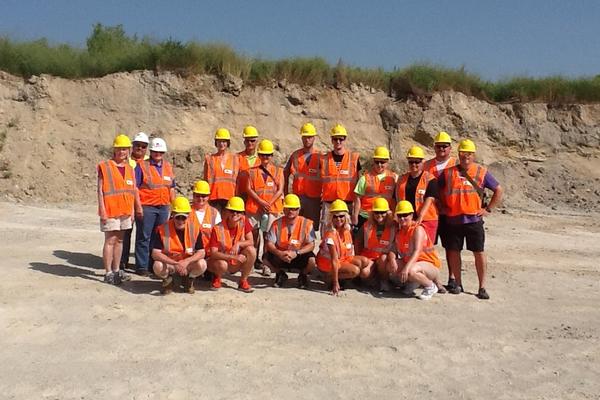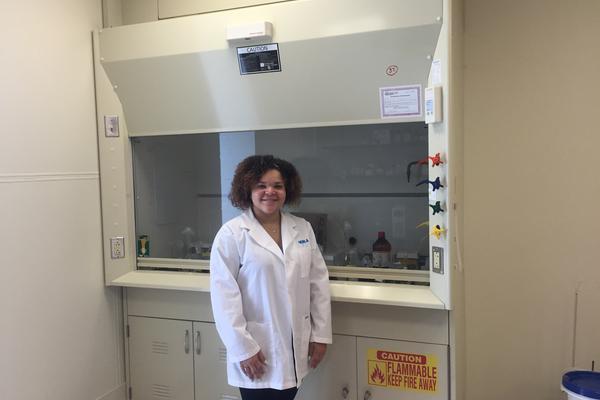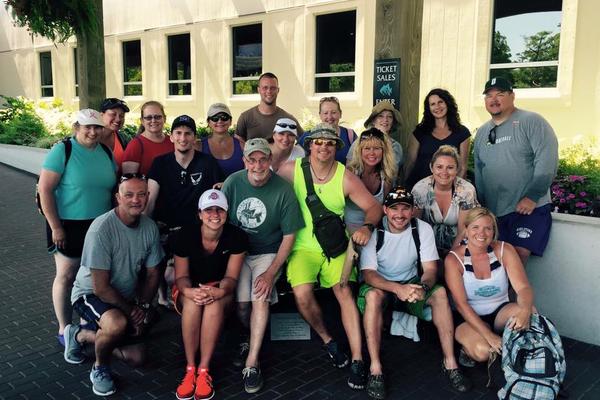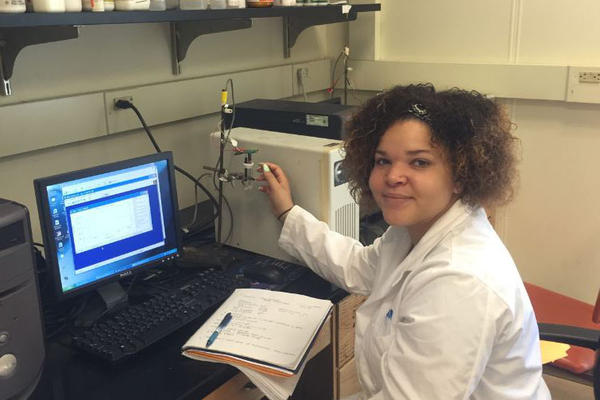
Suzanne Kay Lunsford, Ph.D.
Suzanne Lunsford, Ph.D.
Professional History
Professor, Chemistry Department, Wright State University, Dayton, Ohio 2010
Associate Professor, Chemistry, Wright State University, Dayton, Ohio
Assistant Professor, Chemistry, Wright State University, Dayton, Ohio
Instructor, Chemistry, Wright State University, Dayton, Ohio
Instructor, Miami University
Academic Background
Post-Doctoral Associate, University of Cincinnati
Ph.D., Analytical Chemistry, University of Cincinnati
B.S., Chemistry, Xavier University, Cincinnati, Ohio
Research Interests:
Development of Surface Modified Electrodes,
Chemical Education Research/Chemistry Based Modules
Current Projects:
Development of electrochemical sensors that detect common neurotransmitters in the presence of common interferents such as ascorbic acid. Additional sensor development for detection of heavy metals in soil and water/ synthesis characterization of sol-gel nanoparticles (Zirconium Dioxide, Titanium Dioxide and various mixtures) have been studied. Most recent work has aspects of Carbon Nanotube (CNT) polymer modified sensor electrode development to detect common heavy metals at low concentrations (ppb level). Collaborative investigations with Dr. Afzal Shah research group, graduate students from the Quaid-i-Azam University in Department of Chemistry, for the development of sensors. These sensors studied to detect toxic compounds such as 2-butanone with Ag-Cu alloy nanoparticles synthesized onto a carbon electrode compared to pure Ag or pure Cu nanoparticles. Additional collaborative work with the University of Central Florida (UCF) has engaged undergraduate students to utilize electrochemical techniques integrated with Raman spectroscopy to build upon the multidisciplinary aspects of physics with chemistry modules. REEL (Research Experiences to Enhance Learning) for undergraduate students in chemistry continues to build inquiry lab modules to meet real-world investigations that enhance students’ interest in STEM (Science, Technology, Engineering and Medicine) fields of research. Project PIES (Partners in Integrated Earth Systems Science) and Project STONE (Science Teaching for Ohio's New Economy) are professional development workshops for graduate students (in-service teachers) to develop upon inquiry-based science experiences that may be utilized in their own school districts. PIES is a unique program that takes teachers to Duke University Marine Lab on a field trip to the Atlantic Ocean to learn water chemistry and geology as an interdisciplinary science experience. These field experiences with PIES and STONE help graduate students become better with developing inquiry-based lessons for their own students to meet state (Ohio Revised Science Standards) and national standards.
Dr. Suzanne Lunsford
466 Oelman Hall
Department of Chemistry
3640 Colonel Glenn Hwy
Dayton, Ohio 45435-0001 USA
Voice: 937.775.2480
Fax: 937.775.2717
Email: suzanne.lunsford@wright.edu
URL: http://www.chm.wright.edu/lunsford
Teaching
Courses Taught by Suzanne K. Lunsford
Chemistry 4200: Senior Inorganic Chemistry
Chemistry 1020: Elementary Organic Chemistry
Chemistry 1230: Reaction Dynamics
Chemistry 2460 Pre-service chemical education, part I
Chemistry 3460 Pre-service chemical education, part II
Chemistry 5200 Graduate course Inorganic Chemistry
Chemistry 6450 Concepts in Chemistry I part of Interdisciplinary Master of Science in Teaching
Chemistry 6500 Concepts in Chemistry II part of Interdisciplinary Master of Science in Teaching
Chemistry 6980 Graduate level chemistry course funded by the Ohio Board of Regents –Project PIES, Environmental Science Course held at Duke University Marine Lab; PI: Suzanne K. Lunsford years 2006 - present.
Research Statement
Research Experience
Physical science professional development research integrating the National Science Education Standards and the Ohio State Standards in all science classrooms. Utilizing and developing inquiry-based physical science lessons to analyze content gains and achievements in school districts and assist in retaining the content knowledge. Additionally, analytical labs are being devised into an inquiry-based method/problem solving scheme to assist in the development of undergraduate research students' skills in electroanalytical chemistry and instrumental analysis.
Research Skills
Recent research has been working on modifying electrodes with organic and inorganic functional groups that will assist with developing a selective sensor to detect common organic and biological molecules such as phenols/neurotransmitters.
Providing professional development workshops/opportunities to help in-service teachers in the northern Ohio area develop inquiry-based science lessons that are needed to meet the national and state standards in their science classrooms. Assisting teachers with technological and analytical instrumental skills needed for today's classroom. Providing on-line science course for teachers who have participated in the "Partners in Integrated Earth Systems Science." Assist teachers with instrumental /laboratory/technological skills in order to develop classrooms to meet all students needs regardless of any physical or learning disabilities.
Instrumental research skills include: modifying electrode surfaces, developing sensors, CV, HPLC, GC, IR, UV-VIS, and NMR spectroscopy and spectroelectrochemistry.
Development of Surface Modified Electrodes
Catechol and catecholamines are important neurotransmitters secreted in the brain and control locomotion. Mental and behavioral disorders such as Schizophrenia, attention deficient disorder, Alzheimer’s disease, Parkinson’s disease, eating disorders, epilepsy, amphetamine addiction, cocaine addiction are all associated with altered levels of the neurotransmitters in the brain. Therefore, a technique for detecting these neurotransmitters could lead to rehabilitation for these common disorders and diseases.
Research studies of interest involve modification of electrode surfaces utilizing conducting polymers as detectors for neurotransmitters. Over the years, conducting polymers have been utilized in various ion-selective electrodes and have been ideal because of their chemical recognition function and high chemical stability. The present interest is to study the development of a novel type of poly crown ether electrode that is capable of selectively determining some 1,2 dihydroxybenzenes (neurotransmitters).
Chemical Education Research/Chemistry Based Modules
Chemistry by Inquiry is a set of laboratory-based modules that provide step-by-step introduction to chemistry and the chemical concepts. The Chemistry by Inquiry laboratory based modules is being extensively researched and tested in the classroom. These lab-based modules are being researched and developed:
- To prepare pre-service and inservice K-12 teachers to teach chemistry as a process of inquiry
- to help underprepared students succeed in the mainstream chemistry courses that are the gateway to science related careers
- to provide liberal arts students with direct experience in the scientific process thus establishing a solid foundation for scientific literacy
Publications
Suzanne Lunsford, Ph.D. - Most Recent Publications
The primary corresponding author of the published articles is in bold type.
R=Refereed, N=Not Refereed
1. Interdisciplinary Program for In-Service Teachers; Working with Industry and University to Enhance Learning Experiences in the State of Ohio (Invited paper), Lunsford, S., Journal of Systemic, Cybernetics, and Informatics; Vol 12, Number 7, 13-16 (2014). R
2. Inter-disciplinary Inquiry Based Science Experiences for the 21st Century; Lunsford, S., Journal of Systemic, Cybernetics, and Informatics ; Vol 12, Number 5, 7-9 (2014). R
3. A Carbon Paste Electrode with Mixture of Zirconium Dioxide and Titanium Dioxide to Detect Heavy Metals Studied by SEM and XPS, Sullivan, M., Spradlin, C., Nguyen, V., and Lunsford, S., ECS Trans., Vol. 61, Number 19, 25-36 (2014), doi:10.1149/06119.0025ecst. R 9
4. Polyeugenol Modified Electrode for Selective Determination of Neurotransmitter atechol in the Presence of Ascorbic Acid on Different Working Electrodes, Spradlin, C., Sullivan, M., Tolias, T., and Lunsford, S., Chemical Educator, 19, 1-4 (2014). R
5. The Crisis of Water Contamination Containing Lead and Detection of Heavy Metals by Square Wave Anodic Stripping Voltammetry, Spradlin, C., Sullivan, M., Nguyen, P., and Lunsford, S., Chemical Educator 19, 194-197 (2014). R
6. Square Wave Anodic Stripping Voltammetry Analysis of Arsenic Using Gold and Silver Electrode, Spradlin, C., Nguyen, P., and Lunsford, S., Chemical Educator 19, 58-60 (2014). R









